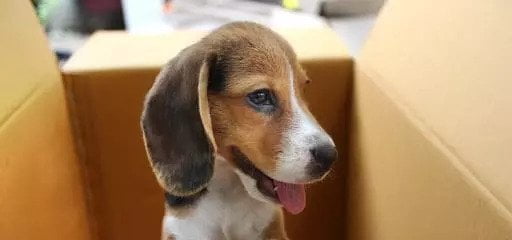Moving house can be one of the most stressful events of your year, but it can have an even greater impact on the family members that won’t understand what’s going on.
Planning for your pets is just as important as planning for moving day. Your dog or cat (or both!) can get anxious as soon as the boxes come out and their favourite objects get packed away.
Here are some tips to make sure your furry (or feathery or finny) companion’s home transition goes as smoothly as possible.
Preparing Your Pet For The Big Day
It’s a good idea to prepare your pet for the eventual move weeks in advance of moving day. If they are flying interstate or overseas, you need to have an airline approved travel crates. Make sure this is the first new box they see.
Your pet will have to become accustomed to this scary, new animal transport crate in the house. Put its favourite bedding or toy inside. Make it comfortable and encourage your pet to explore it.
The travel crate has to become a second home within the house so when everything else gets disturbed you can rest assured that they will experience stress free air travel safely in their box. During the airport to airport service, at least you’ll know they have a piece of comfort with them at all times.
Even if it’s just a car ride down the street, making your pet feel at home in their carrier will make the trip door to door a lot less stressful for both of you.

Pack For Your Pet
In a separate, clearly marked box, pack away your pet’s essentials. Food, toys, cleaning brushes, blankets, kitty litter — have it all in the one place so after you’ve arrived safely in your new home your pet has everything they need on hand in the first few days of unpacking.
Before moving pets, contact their vet and let them know that you’re moving. If it’s far enough away that you have to change vets, get your vet to recommend a new clinic and send your pet’s record there.
The Big Day: Moving Your Pet
When the big day arrives, there are a few measures you can take to ensure the removalists don’t scare off your pet. In our time we’ve seen some runners (and flyers!), no matter how docile or compliant our customers claim their pet to be.
It helps to have your pet in their carrier (or birdcage) in the calmest room in the house. Perhaps move furniture and boxes out of the room before the movers arrive and keep the pet in there with the door closed until you’re ready to put them in the car. Think of it as their transit lounge. Not only does this keep the animal more relaxed, but also keeps them out of our packers’ way.
At the new place, it’s a good idea to have another transit lounge ready for your pet to tentatively explore. Keep the door closed and let them come out of the travel crate in their own time. Put some of your worn clothes or other familiar smelling things around the room.
Getting your pet accustomed to their new environment takes time. Make a checklist including some of these suggestions and you’ll all be settled in before you know it.
Moving Your Pet With V-Move
With years of experience, we are pet friendly, experienced professionals who want to offer the best customer service when it comes to getting your whole family into your new home. Whether you’re in the western suburbs, or eastern suburbs, the inner west, the north shore, or the northern beaches, V-Move are the removalists to call for all your moving needs.








